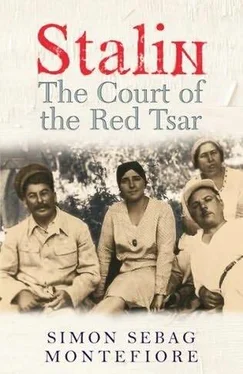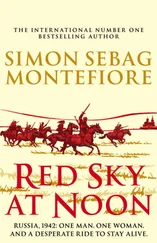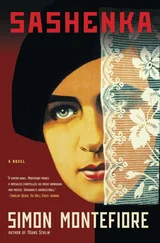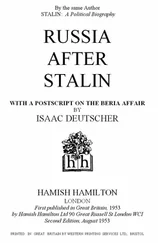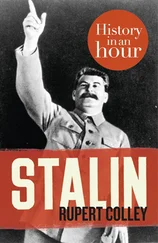These provincials wanted to meet their heroes and a great amount of time was spent posing for the photographers in the hall where they gathered in eager groups, beaming, in their boots, tunics and caps, around Stalin, Kalinin, Voroshilov, Kaganovich and Budyonny. At the Fifteenth Congress in 1927, Stalin was just one of the leaders who posed with his fans. At the Seventeenth, Stalin is always at the centre. The album is mutilated by the huge number of figures either crossed out or cut out as they were arrested and executed during the following four years: out of 1,966 delegates, 1,108 would be arrested. Few survived.
Named, of course, after Beria’s former patron, Ordzhonikidze, a friendship that had disintegrated into mutual hatred.
It was no coincidence that he would become such a fan of Western cowboy movies.
Among his possessions in his apartment, preserved in Leningrad, is one of his cigarette boxes emblazoned with an unprepossessing portrait of Stalin with a very long nose. The box is opened by pressing the nose.
When Stalin read Andrei Platonov’s satire on the “Higher Command” of collectivization, For Future Use , he supposedly wrote “Bastard!” on the manuscript and told Fadeev, “Give him a belt ‘for future use.’” Platonov was never arrested but died, in great deprivation, of TB.
There was one other returned émigré whom Stalin personally favoured. Ilya Ehrenburg, a Muscovite and Jewish Bohemian novelist, friends with Picasso and Malraux, complained of persecution by the Party. His old schoolfriend Bukharin appealed for him. Stalin scrawled on the letter: “To Comrade Kaganovich, pay attention to the attached document—don’t let the Communists drive Ehrenburg mad. J. Stalin.” Molotov and Bukharin helped Mandelstam. Voroshilov aided his own stable as well as his “court painter” Gerasimov. Kirov protected the Mariinsky Ballet, Yenukidze the Bolshoi. Yagoda patronised his own writers and architects, often meeting them at Gorky’s mansion. Poskrebyshev received the tenor Kozlovsky at home.
His wife Zinaida was even prissier: she once told Svetlana Stalin that the urbane novelist Ehrenburg “loves Paris because there are naked women there.” It was Zinaida who was tactless enough to tell Svetlana her mother was mentally “sick.”
Yury Zhdanov, the boy at table with Stalin, Kirov and his father, is the main source for this account and now lives in Rostov-on-Don where he generously agreed to be interviewed for this book. The holiday became famous because of Kirov’s fate soon afterwards: it forms a set piece in Anatoly Rybakov’s novel Children of the Arbat . Yury Zhdanov remembers Stalin asking him: “What was the genius of Catherine the Great?” He answered his own question. “Her greatness lay in her choice of Prince Potemkin and other such talented lovers and officials to govern the State.”
When the writer Mikhail Sholokhov criticized the praise for the leader, Stalin replied with a sly smile, “What can I do? The people need a god.”
After the Seventeenth Congress, formal Politburo meetings became gradually less frequent. Often a Politburo sitting was really just Stalin chatting with a couple of comrades: Poskrebyshev’s minutes are simply marked “Comrades Stalin, Molotov, Kaganovich—for” and the others were sometimes telephoned by Poskrebyshev who marked their votes and signed his “P” underneath. By the end of the year, there was one meeting in September, none in October and one in November.
Instantsiya derives from the nineteenth-century German usage of aller instanzen , meaning to appeal to the highest court.
The Taurida Palace had been the scene of Prince Potemkin’s extravagant ball for Catherine the Great in 1791 but it was also the home of the Duma, the Parliament gingerly granted by Nicholas II after the 1905 Revolution. In 1918, the palace housed the Constituent Assembly that Lenin ordered shut down by drunken Red Guards. It was thus both the birthplace and graveyard of Russia’s first two democracies before 1991.
This brain study was part of the rationalist-scientific ritual of the death of great Bolsheviks. Lenin’s brain had been extracted and was now studied at the Institute of the Brain. When Gorky died, his brain was delivered there too. This was surely a scientific Marxist distortion of the tradition in the Romantic age for the hearts of great men, whether Mirabeau or Potemkin, to be buried separately. But the age of the heart was over.
Maria’s poem reveals both the devotion and cheekiness of Stalin’s female courtiers: “We wish much happiness to our Dear Leader and endless life. Let the enemies be scared off. Liquidate all Fascists… Next year, take the world under your sway, and rule all mankind. Shame the ladies can’t go West to Carlsbad. It’s all the same at Sochi.”
Even today, those that know such secrets persist in believing, in the words of Stalin’s adopted son General Artyom Sergeev, now eighty, that his “private life is secret and irrelevant to his place in history.”
Here was Stalin’s version of Harold Macmillan’s “You’ve never had it so good.”
The star was his wife Liuba Orlova and the songs were by the Jewish songwriter Isaac Dunaevsky. The Russians, emerging from an era of starvation and assassination, flocked to see musicals and comedies—like Americans during the Depression. The style was singing, dancing and slapstick: a pig jumps onto a banqueting table, causing much messy hilarity with trotters and snout.
Mikoyan and Chubar, a senior official in Ukraine, as the two senior candidate members of the Politburo, were made full members, with Zhdanov and Eikhe, boss of West Siberia, taking their place as candidates.
This dacha, built by a Jewish millionaire, later known as Dom (house of) Ordzhonikidze and now notorious as “Stalin’s house,” was a favourite of the leadership: the founder of the Cheka, Felix Dzerzhinsky, often stayed there. Trotsky was recuperating there at the time of Lenin’s death when Stalin and Ordzhonikidze managed to ensure he missed the funeral. Stalin (and Beria) stayed here after World War II: the grand billiard room was installed specially for him and he took a great interest in the lush trees and flowers planted by local Party bosses up to his death. In one of the most sinister parts of the research for this book, the author stayed almost alone in this strange but historic house, probably in Mandelstam’s attic.
As Stalin wrote his history books with his dear friends Zhdanov and Kirov, he was receiving detailed reports on the health of his “precious” comrade. The Yezhov case is a classic illustration of the Party’s obsessive control over every detail of its leaders. “The radioactive baths of Badgastein” had improved Yezhov’s health, the embassy reported after five days. A few days later, the patient was feeling energyless after the baths, he was following a diet but he was still chain smoking—and the sores on his thighs and legs had almost disappeared. The CC voted to send him the huge sum of 1,000 roubles. Next he had pains in his appendix, but having consulted Moscow doctors, Kaganovich sent an order that he was not to undergo surgery “unless absolutely necessary.” After another rest in an Italian sanatorium, the Yezhovs returned that autumn.
Читать дальше
